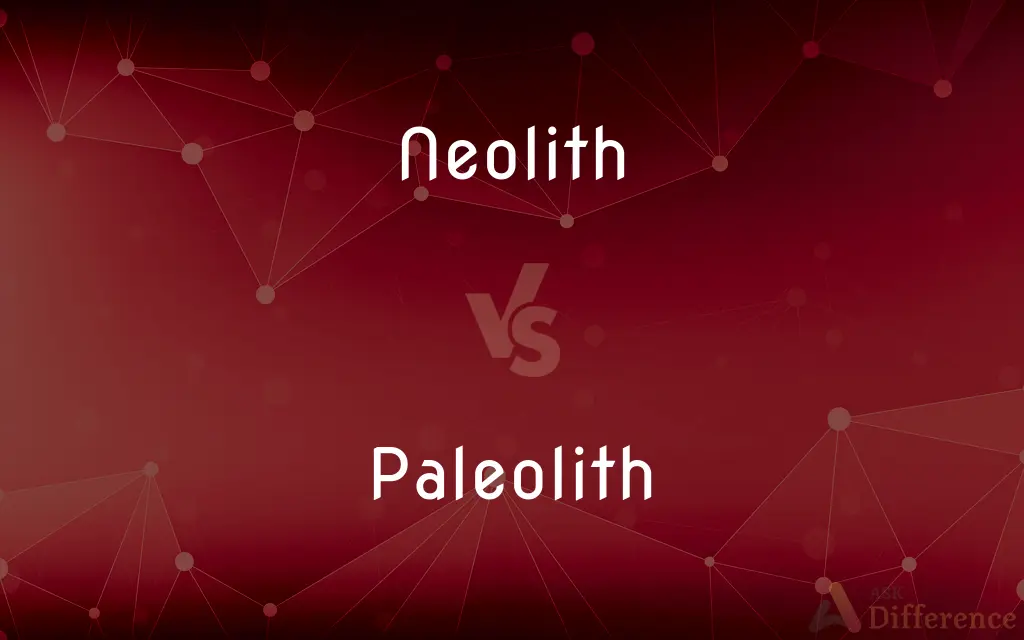Neolith vs. Paleolith — What's the Difference?
By Maham Liaqat & Fiza Rafique — Updated on April 26, 2024
Neolithic era marks the dawn of agriculture and settled communities, whereas the Paleolithic era is characterized by hunter-gatherer societies and the earliest known use of tools.

Difference Between Neolith and Paleolith
Table of Contents
ADVERTISEMENT
Key Differences
The Neolithic, also known as the New Stone Age, began around 10,000 BCE with the development of farming, whereas the Paleolithic or Old Stone Age, dating from approximately 2.5 million years ago, was dominated by hunting and gathering.
In the Neolithic era, communities began to settle in fixed locations due to agriculture, whereas Paleolithic humans were nomadic, moving with animal migrations and seasonal growth cycles.
Neolithic advancements include the domestication of plants and animals, leading to the rise of agriculture, whereas Paleolithic people depended on wild plants and animals for survival.
The tools in the Neolithic period were more refined and included agricultural implements like sickles and grinding stones, whereas Paleolithic tools were primarily simple stone and bone tools for hunting and butchering.
Art in the Neolithic era often depicted agricultural scenes and domesticated animals, reflecting settled life, whereas Paleolithic art, such as cave paintings, typically portrayed wild animals and hunting scenes.
ADVERTISEMENT
Comparison Chart
Time Period
About 10,000 BCE to 4,500 BCE
About 2.5 million years ago to 10,000 BCE
Lifestyle
Settled farming communities
Nomadic hunter-gatherers
Tools
Advanced stone tools, pottery
Simple stone tools, no pottery
Subsistence
Agriculture, animal domestication
Hunting and gathering
Art
Agricultural motifs, pottery
Cave paintings, portable art
Compare with Definitions
Neolith
The final division of the Stone Age, characterized by the first development of farming.
The Neolith marked a profound shift in how societies were structured and supported.
Paleolith
Known for cave paintings and other forms of prehistoric art.
The Lascaux cave paintings are a famous example of Paleolithic creativity.
Neolith
Characterized by the development of permanent settlements.
Neolithic settlements often featured homes built from mud bricks.
Paleolith
Characterized by the use of flint tools and the absence of pottery.
Paleolithic technology primarily involved flint knapping techniques.
Neolith
Era noted for the advent of domesticated animals and settled agricultural communities.
During the Neolith, goats and sheep were among the first animals to be domesticated.
Paleolith
The earliest part of the Stone Age, marked by the first use of stone tools.
Tools found from the Paleolith include simple choppers made from flint.
Neolith
Period associated with the creation of pottery.
Pottery from the Neolith varies greatly in style and decoration across different regions.
Paleolith
An era dominated by nomadic groups dependent on hunting and gathering.
Paleolithic people often moved seasonally to follow game and gather ripe fruits.
Neolith
Time of significant technological and social advancements.
Neolithic tools represented a major advancement over those from the Paleolithic era.
Paleolith
Period before the advent of agricultural practices.
The Paleolith spans a vast period during which humans slowly developed more sophisticated tools.
Neolith
A stone implement of the Neolithic Period.
Paleolith
A paleolith or palaeolith is an archaic word for a stone relic of the Paleolithic era. "Palæolith: a rude stone implement or object of the earlier stone age".
Neolith
A stone implement from the Neolithic era.
Paleolith
A stone implement of the Paleolithic Period.
Neolith
A stone tool from the Neolithic Age
Paleolith
A relic from the Paleolithic era.
Paleolith
A relic of the Paleolithic era.
Paleolith
A stone tool from the Paleolithic age
Common Curiosities
What type of art is associated with the Paleolithic era?
The Paleolithic era is known for cave paintings and carvings, reflecting a focus on hunting and the natural world.
How did the diet of Neolithic people differ from that of Paleolithic people?
Neolithic diets included domesticated plants and animals, whereas Paleolithic diets relied on wild sources.
Why is the Neolithic considered a turning point in human history?
It marks the beginning of agriculture and settled life, which led to the development of civilizations.
What distinguishes the Neolithic from the Paleolithic era in terms of tool technology?
Neolithic tools were more advanced and specialized, including pottery and agricultural implements, while Paleolithic tools were simpler, mainly for hunting and cutting.
What are the social structures like in the Neolithic era compared to the Paleolithic?
Neolithic societies were more complex and hierarchical due to settled life and agriculture, unlike the egalitarian and nomadic Paleolithic groups.
What impact did the Neolithic agricultural revolution have on human populations?
The adoption of agriculture during the Neolithic led to population increases due to more reliable food sources, unlike the smaller, nomadic groups of the Paleolithic.
How did the role of women likely change from the Paleolithic to the Neolithic era?
The role of women likely expanded in Neolithic societies due to their involvement in agriculture and animal care, whereas in Paleolithic times, roles were more directly connected to gathering and supporting hunter activities.
How did housing structures differ between the Neolithic and Paleolithic eras?
Neolithic people built permanent dwellings using materials like mud bricks and stone, whereas Paleolithic people used temporary shelters like tents and caves.
What role did animals play in Neolithic societies compared to Paleolithic societies?
In Neolithic societies, animals were domesticated for food, labor, and companionship, a significant shift from the Paleolithic era, where animals were primarily hunted for food.
Can you explain the significance of pottery in the Neolithic era?
Pottery, which appeared during the Neolithic, was crucial for storing food and water, reflecting settled life and technological innovation absent in the Paleolithic.
Share Your Discovery

Previous Comparison
Anatomy vs. Physiology
Next Comparison
Condo vs. TownhouseAuthor Spotlight
Written by
Maham LiaqatCo-written by
Fiza RafiqueFiza Rafique is a skilled content writer at AskDifference.com, where she meticulously refines and enhances written pieces. Drawing from her vast editorial expertise, Fiza ensures clarity, accuracy, and precision in every article. Passionate about language, she continually seeks to elevate the quality of content for readers worldwide.














































